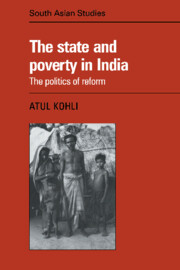Book contents
- Frontmatter
- Contents
- List of Tables and Figures
- Acknowledgements
- Introduction
- 1 The State and Redistributive Reforms
- 2 Democracy and Development in India: an Interpretation
- 3 West Bengal: Parliamentary Communism and Reform from above
- 4 Karnataka: Populism, Patronage, and Piecemeal Reform
- 5 Uttar Pradesh: Political Fragmentation, Middle-Peasant Dominance, and the Neglect of Reforms
- 6 Conclusion: The State and Reform in Democratic–Capitalist Development
- Appendix I On the Political Relevance of Social Classes in a Developmental Setting
- Appendix II Does Agriculture Growth Really “Trickle-down” in India?
- Bibliography
- Index
- CAMBRIDGE SOUTH ASIAN STUDIES
2 - Democracy and Development in India: an Interpretation
Published online by Cambridge University Press: 27 October 2009
- Frontmatter
- Contents
- List of Tables and Figures
- Acknowledgements
- Introduction
- 1 The State and Redistributive Reforms
- 2 Democracy and Development in India: an Interpretation
- 3 West Bengal: Parliamentary Communism and Reform from above
- 4 Karnataka: Populism, Patronage, and Piecemeal Reform
- 5 Uttar Pradesh: Political Fragmentation, Middle-Peasant Dominance, and the Neglect of Reforms
- 6 Conclusion: The State and Reform in Democratic–Capitalist Development
- Appendix I On the Political Relevance of Social Classes in a Developmental Setting
- Appendix II Does Agriculture Growth Really “Trickle-down” in India?
- Bibliography
- Index
- CAMBRIDGE SOUTH ASIAN STUDIES
Summary
India has now undergone three decades of politically guided development. Shorn of many complexities, the record is clear. Democracy has survived. Industry and agriculture have both grown at moderate rates. Redistributive efforts have, however, not been very successful. As much as 40 percent of the population continues to live in conditions of absolute poverty. Why has a democratically planned economy, committed to “socialism,” failed to improve, even moderately, the living conditions of the lower classes? An adequate analysis of this issue is a necessary first step in exploring the scope and the limitations of distributive possibilities within contemporary India.
This chapter does not present new empirical materials. It rather reinterprets some of the major themes in India's political economy so as to focus attention on the political roots of redistributive failures in India. It is argued here that the failure of the Indian state to facilitate social reforms has resulted from a tacit ruling alliance between a loosely organized, ruling nationalist elite and those property owners who are in a position to stimulate economic growth. The loose and heterogeneous nature of the ruling coalition has made it difficult for the political authorities to intervene in a rigid, hierarchical society so as to benefit the poor. Political and social-structural characteristics are thus both crucial for understanding redistributive outcomes in India. As social-structural constraints are not likely to vary significantly in the short run, poverty conditions will only alter with changing regime types and policies.
- Type
- Chapter
- Information
- The State and Poverty in India , pp. 51 - 93Publisher: Cambridge University PressPrint publication year: 1987



